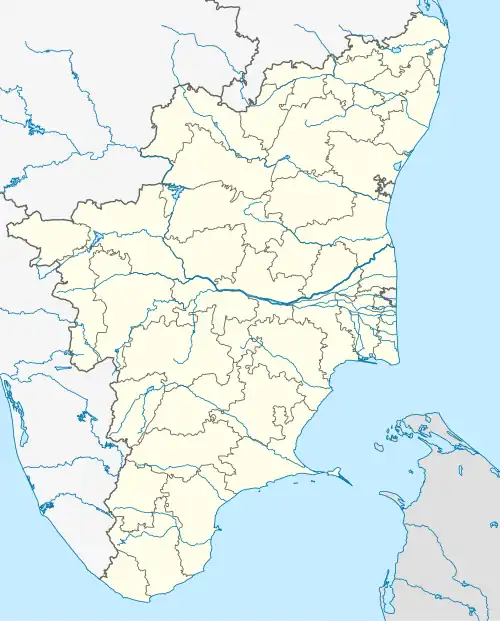Jalakandapuram
Jalakandapuram | |
|---|---|
 Jalakandapuram Location in Tamil Nadu, India | |
| Coordinates: 11°42′N 77°53′E / 11.7°N 77.88°E | |
| Country | India |
| State | Tamil Nadu |
| District | Salem |
| Area | |
• Total | 4.66 km2 (1.80 sq mi) |
| Population (2011) | |
• Total | 16,184 |
| • Density | 3,500/km2 (9,000/sq mi) |
| Languages | |
| • Official | Tamil |
| Time zone | UTC+5:30 (IST) |
Jalakandapuram is a panchayat town in Mettur taluk of Salem district in the Indian state of Tamil Nadu. It is one of the 31 panchayat towns in the district. Spread across an area of 4.66 km2 (1.80 sq mi), it had a population of 16,184 individuals as per the 2011 census.
Geography and administration
Jalakandapuram is located in Mettur taluk of Salem district in the Indian state of Tamil Nadu.[1][2] Spread across an area of 4.66 km2 (1.80 sq mi),[3] it is located about 35 km (22 mi) from the district headquarters Salem.[1] It is one of the of the 31 panchayat towns in the district.[4] The town panchayat is headed by a chairperson, who is elected by the members, who are chosen through direct elections.[5] The town forms part of the Edappadi Assembly constituency that elects its member to the Tamil Nadu legislative assembly and the Salem Lok Sabha constituency that elects its member to the Parliament of India.[6]
Climate
The region has a tropical climate with hot summers and mild winters. The highest temperatures are recorded in April and May, with lowest recordings in December-January.[7]
| Climate data for Jalakandapuram | |||||||||||||
|---|---|---|---|---|---|---|---|---|---|---|---|---|---|
| Month | Jan | Feb | Mar | Apr | May | Jun | Jul | Aug | Sep | Oct | Nov | Dec | Year |
| Mean daily maximum °C (°F) | 30.9 (87.6) |
33.6 (92.5) |
36.1 (97.0) |
36.8 (98.2) |
36.4 (97.5) |
34.2 (93.6) |
32.6 (90.7) |
32.2 (90.0) |
32.7 (90.9) |
31.1 (88.0) |
30.3 (86.5) |
29.9 (85.8) |
33.1 (91.5) |
| Mean daily minimum °C (°F) | 19.1 (66.4) |
20.2 (68.4) |
22.2 (72.0) |
24.8 (76.6) |
25.1 (77.2) |
24.1 (75.4) |
23 (73) |
23.1 (73.6) |
22.7 (72.9) |
22.7 (72.9) |
21.1 (70.0) |
19.5 (67.1) |
22.3 (72.1) |
| Average precipitation mm (inches) | 8 (0.3) |
11 (0.4) |
17 (0.7) |
50 (2.0) |
101 (4.0) |
49 (1.9) |
78 (3.1) |
106 (4.2) |
113 (4.4) |
182 (7.2) |
88 (3.5) |
36 (1.4) |
839 (33.1) |
| Source: Climate-data.org[8] | |||||||||||||
Demographics
As per the 2011 census, Jalakandapuram had a population of 16,184 individuals across 4,198 households.[9] The population saw a marginal increase compared to the previous census in 2001 when 14,077 inhabitants were registered. The population consisted of 8,138 males and 8,046 females.[3][10] About 1,523 individuals were below the age of six years.[9] About 2.2% of the population belonged to scheduled castes. The entire population is classified as urban. The town has an average literacy rate of 81.5%.[3][9]
About 43.8% of the eligible population were employed, of which majority were involved in agriculture and allied activities.[3][9] Hinduism was the majority religion which was followed by 96.0% of the population, with Islam (3.4%) and Christianity (0.6%) being minor religions.[11]
References
- ^ a b "Jalakandapuram". Government of Tamil Nadu. Retrieved 1 June 2025.
- ^ "Villages of Tamil Nadu" (PDF). Government of Tamil Nadu. Archived from the original (PDF) on 12 November 2024. Retrieved 1 June 2025.
- ^ a b c d "Jalakandapuram". Citypopulation.de. Retrieved 1 June 2025.
- ^ "Town panchayats in Tamil Nadu" (PDF). Government of Tamil Nadu. Retrieved 1 June 2025.
- ^ "Local Government". Government of India. p. 1. Archived from the original on 4 October 2022. Retrieved 1 January 2023.
- ^ Polling stations in Salem district (PDF). Election Commission of India (Report). Retrieved 1 June 2025.
- ^ "Climate". Weather spark. Retrieved 1 June 2025.
- ^ "Climate Data of Jalakandapuram". Climate-data.org. Retrieved 1 June 2015.
- ^ a b c d Geo level data: Census of India 2011 (Report). Census Commission of India. Retrieved 1 June 2025.
- ^ "Census of India 2001: Data from the 2001 Census, including cities, villages and towns (Provisional)". Census Commission of India. Archived from the original on 16 June 2004. Retrieved 1 June 2008.
- ^ Religion: Census of India 2011 (Report). Census Commission of India. Retrieved 1 June 2025.